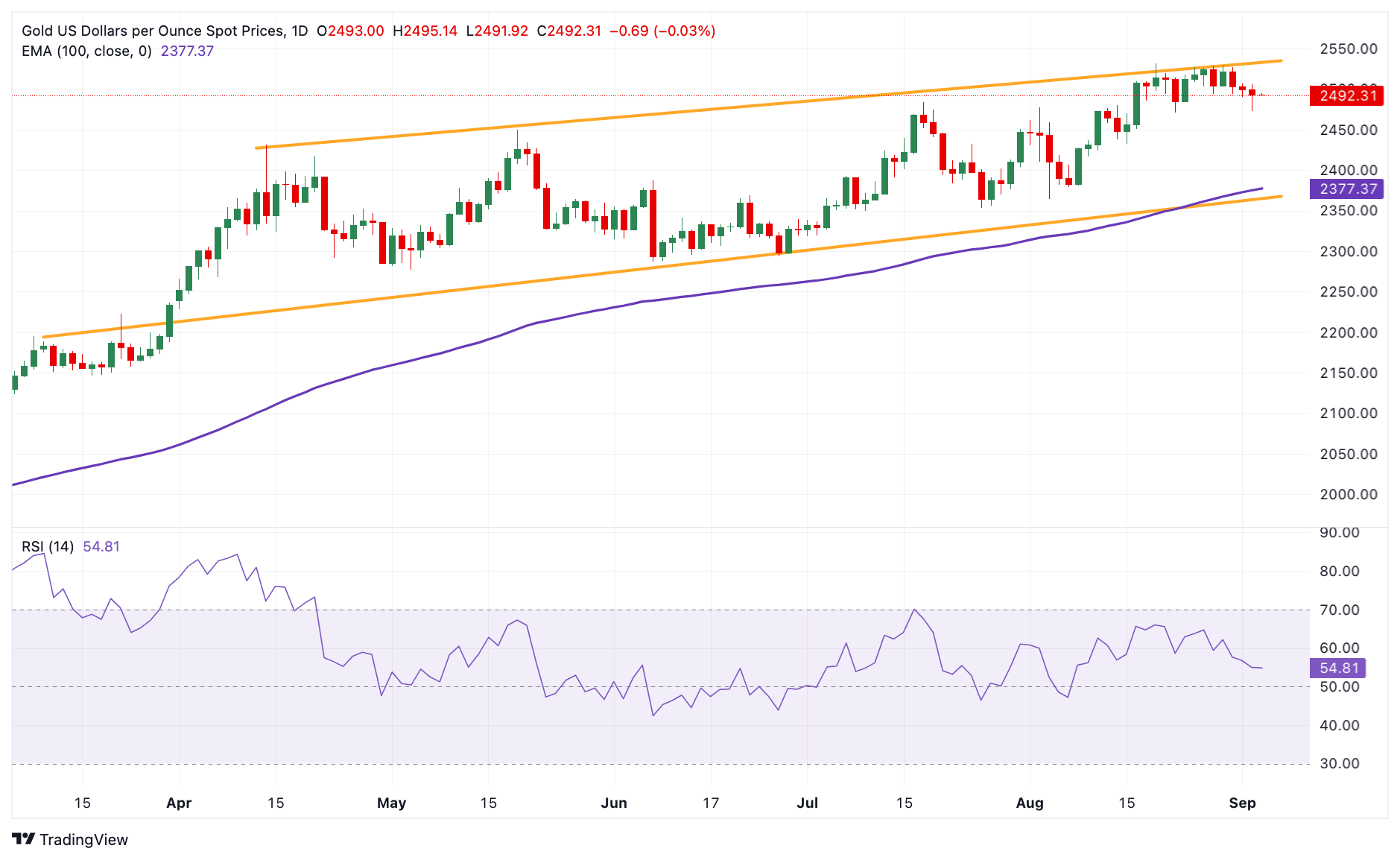- Gold prices are trading lower at the start of the Asian session on Wednesday.
- Escalating geopolitical tensions in the Middle East and expectations of a Fed rate cut could limit gold’s downside.
- JOLTS job openings and the Fed Beige Book will be released later on Wednesday.
Gold (XAU/USD) price bounces off multi-day lows but remains below the $2,500 barrier amid renewed buying bias in the US Dollar (USD) on Wednesday. However, ongoing geopolitical risks and looming Federal Reserve (Fed) rate cuts could benefit the yellow metal in the near term.
Later on Wednesday, JOLTS job openings and the Fed Beige Book will be released. Investors will closely watch the much-anticipated US Non-Farm Payrolls (NFP) for August on Friday, which could determine the size and pace of the potential rate cut at the Federal Reserve’s September policy meeting. If the report shows a weaker-than-expected reading, this could fuel speculation about a US recession and faster rate cuts by the Fed. This, in turn, could further boost the precious metal as lower interest rates reduce the opportunity cost of holding non-yielding gold.
Daily Moves and Market Movers: Gold Price Loses Ground Amid Firm US Dollar
- “We see evidence that speculative positioning in gold is indeed at its maximum at the moment. I think the level at which gold is seeing pressure from the rising dollar reflects our view on positioning,” said Daniel Ghali, commodity strategist at TD Securities.
- The US ISM manufacturing PMI rose to 47.2 in August from an eight-month low of 46.8 in July. This was below the market consensus of 47.5.
- Traders raised the likelihood of a more aggressive cut by half a point to 39%, from 31% before the U.S. ISM manufacturing PMI report, according to the CME Group’s FedWatch measure.
- U.S. JOLTS job openings are expected at 8.10 million, down from 8.184 million in June.
- The US ISM Services PMI is projected to decline to 51.4 in August from 51.1 in July.
Technical Analysis: Gold price maintains a positive long-term outlook
Gold price is trading in negative territory on the day. The precious metal maintains an uptrend on the daily chart as the price is above the 100-day exponential moving average (EMA) and reinforced by the 14-day Relative Strength Index (RSI), which is positioned above the midline.
The crucial upside barrier for the yellow metal emerges at $2,530-$2,540, representing the upper boundary of the five-month ascending channel and the all-time high. A sustained trade above this level could pave the way towards the psychological $2,600 mark.
On the other hand, the immediate support level to watch is $2,470, the low of August 22. A break of said level could see a downside move towards $2,432, the low of August 15. Extended losses will see a drop to $2,377, the 100-day EMA.
Gold FAQs
Gold has played a pivotal role in human history as it has been widely used as a store of value and a medium of exchange. Today, apart from its luster and use for jewelry, the precious metal is considered a safe haven asset, meaning it is considered a good investment in turbulent times. Gold is also considered a hedge against inflation and currency depreciation as it is not dependent on any particular issuer or government.
Central banks are the largest holders of gold. In their aim to support their currencies in turbulent times, central banks tend to diversify their reserves and buy gold to improve the perception of the strength of the economy and the currency. High gold reserves can be a source of confidence in a country’s solvency. Central banks added 1,136 tonnes of gold worth about $70 billion to their reserves in 2022, according to data from the World Gold Council. This is the largest annual purchase on record. Central banks in emerging economies such as China, India and Turkey are rapidly increasing their gold reserves.
Gold has an inverse correlation with the US Dollar and US Treasury bonds, which are the main reserve and safe haven assets. When the Dollar depreciates, the price of Gold tends to rise, allowing investors and central banks to diversify their assets in turbulent times. Gold is also inversely correlated with risk assets. A rally in the stock market tends to weaken the price of Gold, while sell-offs in riskier markets tend to favor the precious metal.
Gold prices can move due to a wide range of factors. Geopolitical instability or fears of a deep recession can cause the price of Gold to rise rapidly due to its status as a safe haven asset. As a non-yielding asset, Gold prices tend to rise when interest rates fall, while rising money prices often weigh down the yellow metal. Still, most of the moves depend on how the US Dollar (USD) performs, as the asset is priced in dollars (XAU/USD). A strong Dollar tends to keep Gold prices in check, while a weaker Dollar is likely to push Gold prices higher.
Source: Fx Street
I am Joshua Winder, a senior-level journalist and editor at World Stock Market. I specialize in covering news related to the stock market and economic trends. With more than 8 years of experience in this field, I have become an expert in financial reporting.








